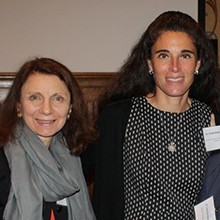Spotlight
Carol Kruchko and Jill Barnholtz-Sloan
March 2020

New Ependymoma Data Helps Raise Awareness and Improve Care
An estimated 1,098 people each year learn they have an ependymoma, while an estimated 13,294 are living with the disease in the United States, according to data published by the Central Brain Tumor Registry of the United States (CBTRUS), a not-for-profit organization. The data were published in 2019 in the Journal of Neuro-Oncology in collaboration with NCI-CONNECT (Comprehensive Oncology Network Evaluating Rare CNS Tumors).
It is also data the CERN Foundation recognized the importance of at its inception. CERN first partnered with CBTRUS in 2007 to use data from 2004 to 2006 to inform its website and educational materials. The CERN team knew then that the CBTRUS data were keys to helping people understand they are not alone in their ependymoma diagnosis.
“Living with a rare disease is very difficult for multiple reasons. One of those difficulties is not having information. Learning more about what you are facing can help you sort out and accept the situation you are dealing with,” says Kimberly Wallgren, President of the CERN Foundation. She worked with CERN Science Advisors, Mark Gilbert, M.D., and Terri Armstrong, Ph.D., to ensure CBTRUS data were collected in a meaningful way, specifically separating spinal and brain tumor data.
“What is notable about our latest published report is that ependymomas have the highest prevalence of all the rare CNS tumors we evaluated,” says Carol Kruchko, president and administrator of CBTRUS. They also have the highest relative five-year survival rate of 83.9%.
Utilizing Ependymoma Data
CBTRUS gathers and shares current epidemiological data – the study of disease burden on a population – of all primary brain and other central nervous system (CNS) tumors. Its purpose is to facilitate research and raise awareness.
The three main epidemiologic measures relating to population and burden of disease that CBTRUS scientists focuses on are:
- Incidence: The number of newly diagnosed cases.
- Prevalence: How many people are living with the disease.
- Survival: The number of patients alive for a certain period of time after their diagnosis.
The data provided to CERN by CBTRUS in 2010 included incidence of primary brain tumors and ependymomas, distribution of childhood primary brain and CNS tumors by histology, five-year survival for primary brain tumors and ependymomas, and overall prevalence for all primary brain tumors.
“What is most interesting about ependymomas are where they occur; both in sites in the brain and in the spinal cord,” says Kruchko.
To educate patients, the 2010 data were first published in Ependymoma Overview, Fast Facts and Statistics, and in its Ependymoma Guide. At the time, CBTRUS self-published its data. A second report was published in 2015 and the most recent report in 2019, both as supplements in Neuro-Oncology.
“Learning meaningful insight into the types of issues people might face or the nature of the disease is empowering and extremely helpful for those dealing with ependymoma,” says Wallgren.
CBTRUS continues to provide reference statistical data on ependymoma found in its annual statistical report and fact sheets. It also utilizes its data to contribute to future literature on the descriptive epidemiology of ependymoma.
“It is important that these data are timely, accurate, complete, and describe and quantify the patients seen by the medical community treating ependymoma,” says Jill Barnholtz-Sloan, Ph.D., scientific principal investigator of CBTRUS and Professor at Case Western Reserve University School of Medicine in Cleveland.
CBTRUS’ goal is to be a resource and contribute to the global understanding of the burden of brain tumors and other CNS cancers. “Only by continuing to report data on ependymoma can CBTRUS provide updates to survival trends. Our hope is that these future data will document the improvements to survival that we hope will happen,” says Kruchko.
